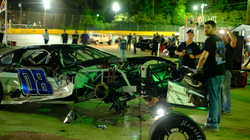BULLRING
By: Gerard Millman
into “America’s Favorite Bullring” to compete in the NASCAR Regional Series against the very racers that inspired him as a child.
10-year-old Carson Haislip stared in awe from the bleachers of Wake County Speedway as the flurry of racecars careened around the quarter-mile track; their mighty, ceaseless roaring softly penetrated little Carson’s heavy-duty earmuffs.

“I was honestly one of the kids that was scared of the sound”, Haislip said, “but I loved watching the cars go around and told my dad I wanna try this.”
Five years later, Haislip stepped into “America’s Favorite Bullring” to compete in the NASCAR Regional Series against the very racers that inspired him as a child.
"I wanted to win in front of her.
That's what I wanted to do before she was gone.
But I couldn't."
 |  |  |  |
|---|---|---|---|
 |  |
In 2007, NASCAR lowered the minimum age requirement for regional level competitions from 18 to 16. In 2022, the age requirement was lowered again to 15¹. These changes reflect two trends: the average age of a NASCAR Cup Series driver is getting younger², and more kids are getting into racing than ever before³.
To get started in motorsports racing, a child normally begins with go-kart racing before gradually working up the ranks of different racing vehicles.
The typical progression of racing vehicles after go-karts into a vehicle driven under the NASCAR banner goes like this:
First, children as young as 7-years-old can race a bandolero car in the INEX Series. Although these cars do not accelerate quickly, they can reach a top speed of 70mph.
Next, racers move to the legend car in the INEX Series. Drivers of
all ages can compete in the legend cars, which can accelerate from 0 to 60mph in four seconds and hit a top speed of 120mph.
Once a driver is ready, they can start racing a late model stock car (LMSC) in the NASCAR Regional Series. An LMSC has about 515 horsepower, more than twice the power of an average midsize car, and reaches a top speed of 200mph.
Most of NASCAR's racing divisions, including their main attraction the NASCAR Cup Series, use a variant of a stock car body type. The LMSC is the least powerful of all the variations, and is effectively the introductory car to racing in NASCAR.

First introduced in 1997 at Charlotte Motor Speedway, the bandolero serves as the entry-level race car for drivers of all ages. Weighing 750lbs, It was designed to be the introductory race car for karting racers, and thus has the same brake/gas pedal configuration as a go-kart. It also has an automatic transmission, so racers do not need to shift gears. Bandoleros racing competitions are divided into two divisions: Bandits Division (Ages 7-11) and Outlaws Division (12+)

First introduced in 1997 at Charlotte Motor Speedway, the bandolero serves as the entry-level race car for drivers of all ages. Weighing 750lbs, It was designed to be the introductory race car for karting racers, and thus has the same brake/gas pedal configuration as a go-kart. It also has an automatic transmission, so racers do not need to shift gears. Bandoleros racing competitions are divided into two divisions: Bandits Division (Ages 7-11) and Outlaws Division (12+)

Legend cars were introduced to the racing world in 1992 to be an affordable option for racers ages 12 and older. Weighing 1,100lbs, these cars have tight specifications to ensure uniformity across all the racers, keeping vehicle costs low and ensuring the winner was the best driver instead of the one who spent the most money. There are four divisions for legend car racers: Young Lions (Ages 10 -15), Semi-Pro (16+), Masters (40+), and Pro (decided of INEX judges).

Legend cars were introduced to the racing world in 1992 to be an affordable option for racers ages 12 and older. Weighing 1,100lbs, these cars have tight specifications to ensure uniformity across all the racers, keeping vehicle costs low and ensuring the winner was the best driver instead of the one who spent the most money. There are four divisions for legend car racers: Young Lions (Ages 10 -15), Semi-Pro (16+), Masters (40+), and Pro (decided of INEX judges).

The Late Model Stock Car was introduced to NASCAR in the late 1970's and has since been the standard race car for professional racers. Variations of the LMSC have been promoted in NASCAR sanctioned events, including the super late model and pro late model, but there is largely no difference between them besides engine horsepower and chassis weight.

The Late Model Stock Car was introduced to NASCAR in the late 1970's and has since been the standard race car for professional racers. Variations of the LMSC have been promoted in NASCAR sanctioned events, including the super late model and pro late model, but there is largely no difference between them besides engine horsepower and chassis weight.
Carson Haislip made the jump from legend car to late model stock car for the 2024 season after winning the 2023 INEX Semi-Pro Legend Car National Championship in Las Vegas, Nevada.
He was 15-years-old.
Since his first victory in the NASCAR Regional Series at Wake County Speedway, Haislip ended his first season with four wins, numerous top five placements, and a 2nd place overall finish in the series. Haislip looks forward to the 2025 season with the goal of one day competing in the southeast's premiere LMSC touring series, the zMAX CARS Tour.
"I'll forever be racing in her name," said Haislip.
"I know she'll always be proud of me."
